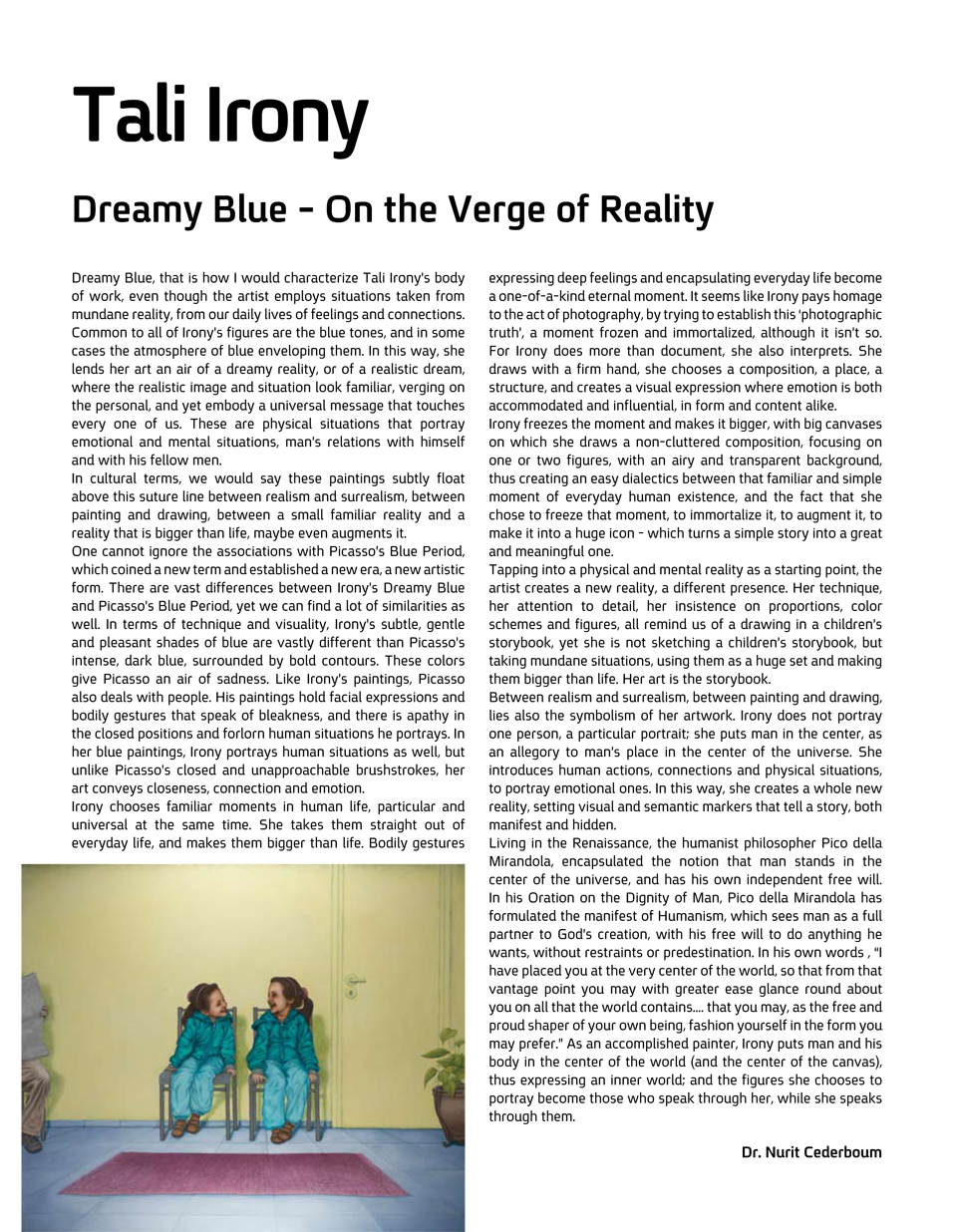
| Home Page | Editor Notices | Museums | Galleries | Publication | Donation | Contact Us |


 | |||||||||||||||
| |||||||||||||||


| |||||||||||||||
| Tali Irony / Dreamy Blue - On the Verge of Reality |
Dreamy Blue, that is how I would characterize Tali Irony’s body of work, even though the artist employs situations taken from mundane reality, from our daily lives of feelings and connections. Common to all of Irony’s figures are the blue tones, and in some cases the atmosphere of blue enveloping them. In this way, she lends her art an air of a dreamy reality, or of a realistic dream, where the realistic image and situation look familiar, verging on the personal, and yet embody a universal message that touches every one of us. These are physical situations that portray emotional and mental situations, man’s relations with himself and with his fellow men. In cultural terms, we would say these paintings subtly float above this suture line between realism and surrealism, between painting and drawing, between a small familiar reality and a reality that is bigger than life, maybe even augments it. One cannot ignore the associations with Picasso’s Blue Period, which coined a new term and established a new era, a new artistic form. There are vast differences between Irony’s Dreamy Blue and Picasso’s Blue Period, yet we can find a lot of similarities as well. In terms of technique and visuality, Irony’s subtle, gentle and pleasant shades of blue are vastly different than Picasso’s intense, dark blue, surrounded by bold contours. These colors give Picasso an air of sadness. Like Irony’s paintings, Picasso also deals with people. His paintings hold facial expressions and bodily gestures that speak of bleakness, and there is apathy in the closed positions and forlorn human situations he portrays. In her blue paintings, Irony portrays human situations as well, but unlike Picasso’s closed and unapproachable brushstrokes, her art conveys closeness, connection and emotion. Irony chooses familiar moments in human life, particular and universal at the same time. She takes them straight out of everyday life, and makes them bigger than life. Bodily gestures expressing deep feelings and encapsulating everyday life become a one-of-a-kind eternal moment. It seems like Irony pays homage to the act of photography, by trying to establish this ‘photographic truth’, a moment frozen and immortalized, although it isn’t so. For Irony does more than document, she also interprets. She draws with a firm hand, she chooses a composition, a place, a structure, and creates a visual expression where emotion is both accommodated and influential, in form and content alike. Irony freezes the moment and makes it bigger, with big canvases on which she draws a non-cluttered composition, focusing on one or two figures, with an airy and transparent background, thus creating an easy dialectics between that familiar and simple moment of everyday human existence, and the fact that she chose to freeze that moment, to immortalize it, to augment it, to make it into a huge icon - which turns a simple story into a great and meaningful one. Tapping into a physical and mental reality as a starting point, the artist creates a new reality, a different presence. Her technique, her attention to detail, her insistence on proportions, color schemes and figures, all remind us of a drawing in a children’s storybook, yet she is not sketching a children’s storybook, but taking mundane situations, using them as a huge set and making them bigger than life. Her art is the storybook. Between realism and surrealism, between painting and drawing, lies also the symbolism of her artwork. Irony does not portray one person, a particular portrait; she puts man in the center, as an allegory to man’s place in the center of the universe. She introduces human actions, connections and physical situations, to portray emotional ones. In this way, she creates a whole new reality, setting visual and semantic markers that tell a story, both manifest and hidden. Living in the Renaissance, the humanist philosopher Pico della Mirandola, encapsulated the notion that man stands in the center of the universe, and has his own independent free will. In his Oration on the Dignity of Man, Pico della Mirandola has formulated the manifest of Humanism, which sees man as a full partner to God’s creation, with his free will to do anything he wants, without restraints or predestination. In his own words , “I have placed you at the very center of the world, so that from that vantage point you may with greater ease glance round about you on all that the world contains.... that you may, as the free and proud shaper of your own being, fashion yourself in the form you may prefer.” As an accomplished painter, Irony puts man and his body in the center of the world (and the center of the canvas), thus expressing an inner world; and the figures she chooses to portray become those who speak through her, while she speaks through them. Dr. Nurit Cederboum Read more  |
| all rights reserved - CAN ISRAELI ART REALITY |
| סייבורג מחשבים - בניית אתרים |